Penetration Efficiency and Concentration Distribution of Nanoparticles in a Hollow Tapered Cylinder
Abstract
:1. Introduction
2. Methods
3. Results and Discussions
3.1. Concentration Distribution of Nanoparticles
3.2. Concentration Profile at Different Positions
3.3. Penetration Efficiency
3.4. Influence of Conical Column
4. Conclusions
Author Contributions
Funding
Institutional Review Board Statement
Informed Consent Statement
Data Availability Statement
Conflicts of Interest
Nomenclature
| C | particle number concentration |
| inlet particle concentration | |
| concentration at different cross sections | |
| dp | particle diameter |
| D | diffusion coefficient |
| Kn | Knudsen number |
| k | Boltzmann constant |
| mean free path of gas molecules | |
| m | mass of gas molecule |
| P | air pressure |
| Peff | particle penetration efficiency |
| r | position in radial direction |
| center of hollow tapered cylinder at inlet | |
| radius of conical column at inlet | |
| radius of hollow tapered cylinder at inlet | |
| radius of hollow tapered cylinder at outlet | |
| center of hollow tapered cylinder at outlet | |
| radial distance | |
| T | absolute temperature |
| air velocity in radial direction | |
| air velocity in axial direction | |
| inlet velocity in axial direction | |
| axial velocity at different cross sections | |
| air velocity vector | |
| z | position in axial direction |
| different positions in axial direction | |
| position in axial direction at outlet | |
| α | accommodation coefficient |
| air density | |
| air kinematic viscosity | |
| coefficient of friction |
References
- Gomez, V.; Irusta, S.; Balas, F.; Navascues, N.; Santamaria, J. Unintended emission of nanoparticle aerosols during common laboratory handling operations. J. Hazard. Mater. 2014, 279, 75–84. [Google Scholar] [CrossRef] [PubMed]
- Jeevanandam, J.; Barhoum, A.; Chan, Y.S.; Dufresne, A.; Danquah, M.K. Review on nanoparticles and nanostructured materials: History, sources, toxicity and regulations. Beilstein J. Nanotechnol. 2018, 9, 1050–1074. [Google Scholar] [CrossRef] [PubMed] [Green Version]
- Radwan, I.M.; Potter, P.M.; Dionysiou, D.D.; Al-Abed, S.R. Silver nanoparticle interactions with surfactant-based household surface cleaners. Environ. Eng. Sci. 2021, 38, 481–488. [Google Scholar] [CrossRef]
- Bakand, S.; Hayes, A.; Dechsakulthorn, F. Nanoparticles: A review of particle toxicology following inhalation exposure. Inhal. Toxicol. 2012, 24, 125–135. [Google Scholar] [CrossRef]
- Frohlich, E.; Salar-Behzadi, S. Toxicological assessment of inhaled nanoparticles: Role of in vivo, ex vivo, in vitro, and in silico studies. Int. J. Mol. Sci. 2014, 15, 4795–4822. [Google Scholar] [CrossRef] [PubMed]
- Oberbek, P.; Kozikowski, P.; Czarnecka, K.; Sobiech, P.; Jakubiak, S.; Jankowski, T. Inhalation exposure to various nanoparticles in work environment-contextual information and results of measurements. J. Nanopart. Res. 2019, 21, 222–246. [Google Scholar] [CrossRef] [Green Version]
- Fierz, M.; Kaegi, R.; Burtscher, H. Theoretical and experimental evaluation of a portable electrostatic TEM sampler. Aerosol Sci. Technol. 2007, 41, 520–528. [Google Scholar] [CrossRef]
- Gowda, R.P.; Kumar, R.N.; Aldalbahi, A.; Issakhov, A.; Prasannakumara, B.C.; Rahimi-Gorji, M.; Rahaman, M. Thermophoretic particle deposition in time-dependent flow of hybrid nanofluid over rotating and vertically upward/downward moving disk. Surf. Interfaces 2021, 22, 100864. [Google Scholar] [CrossRef]
- Preger, C.; Overgaard, N.C.; Messing, M.E.; Magnusson, M.H. Predicting the deposition spot radius and the nanoparticle concentration distribution in an electrostatic precipitator. Aerosol Sci. Technol. 2020, 54, 718–728. [Google Scholar] [CrossRef]
- Azong-Wara, N.; Asbach, C.; Stahlmecke, B.; Fissan, H.; Kaminski, H.; Sabine, P.; Kuhlbusch, T.A.J. Optimisation of a thermophoretic personal sampler for nanoparticle exposure studies. J. Nanopart. Res. 2009, 11, 1611–1624. [Google Scholar] [CrossRef]
- Thayer, D.; Koehler, K.A.; Marchese, A.; Volckens, J. A personal thermophoretic sampler for airborne nanoparticles. Aerosol Sci. Technol. 2011, 45, 744–750. [Google Scholar] [CrossRef]
- Gowda, R.P.; Kumar, R.N.; Prasannakumara, B.C.; Nagaraja, B.; Gireesha, B.J. Exploring magnetic dipole contribution on Ferromagnetic nanofluid flow over a stretching sheet: An application of Stefan blowing. J. Mol. Liq. 2021, 335, 16215. [Google Scholar]
- Jamshed, W.; Nisar, K.S.; Gowda, R.P.; Kumar, R.N.; Prasannakumara, B.C. Radiative heat transfer of second grade nanofluid flow past a porous flat surface: A single-phase mathematical model. Phys. Scr. 2021, 96, 064006. [Google Scholar] [CrossRef]
- Gowda, R.P.; Al-Mubaddel, F.S.; Kumar, R.N.; Prasannakumara, B.C.; Issakhov, A.; Rahimi-Gorji, M.; Al-Turki, Y.A. Computational modelling of nanofluid flow over a curved stretching sheet using Koo–Kleinstreuer and Li (KKL) correlation and modified Fourier heat flux model. Chaos Soliton Fractals 2021, 145, 110774. [Google Scholar] [CrossRef]
- Kumar, R.N.; Gowda, R.P.; Abusorrah, A.M.; Mahrous, Y.M.; Abu-Hamdeh, N.H.; Issakhov, A.; Rahimi-Gorji, M.; Prasannakumara, B.C. Impact of magnetic dipole on ferromagnetic hybrid nanofluid flow over a stretching cylinder. Phys. Scr. 2021, 96, 045215. [Google Scholar] [CrossRef]
- Cohen, B.S.; Asgharian, B. Deposition of ultrafine particles in the upper airways: An empirical analysis. J. Aerosol Sci. 1990, 21, 789–797. [Google Scholar] [CrossRef]
- Martonen, T.; Zhang, Z.; Yang, Y. Particle diffusion with entrance effects in a smooth-walled cylinder. J. Aerosol Sci. 1996, 27, 139–150. [Google Scholar] [CrossRef]
- Alonso, M.; Huang, C.H. High-efficiency electrical charger for nanoparticles. J. Nanopart. Res. 2015, 17, 332–340. [Google Scholar] [CrossRef] [Green Version]
- Intra, P.; Wanusbodeepaisarn, P.; Siri-achawawath, T. Evaluation of the performance in charging efficiencies and losses of ultrafine particles ranging in sizes from 15 to 75 nm in a unipolar corona-based ionizer. J. Electr. Eng. Technol. 2021, 16, 963–974. [Google Scholar] [CrossRef]
- Gregson, F.K.; Watson, N.A.; Orton, C.M.; Haddrell, A.E.; McCarthy, L.P.; Finnie, T.J.; Gent, N.; Donaldson, G.C.; Shah, P.L.; Calder, J.D.; et al. Comparing aerosol concentrations and particle size distributions generated by singing, speaking and breathing. Aerosol Sci. Technol. 2021, 55, 681–691. [Google Scholar] [CrossRef]
- Gregson, F.K.; Sheikh, S.; Archer, J.; Symons, H.E.; Walker, J.S.; Haddrell, A.E.; Orton, C.M.; Hamilton, F.W.; Brown, J.M.; Bzdek, B.R.; et al. Analytical challenges when sampling and characterising exhaled aerosol. Aerosol Sci. Technol. 2022, 56, 160–175. [Google Scholar] [CrossRef]
- Yang, S.; Lee, G.W.; Chen, C.M.; Wu, C.C.; Yu, K.P. The size and concentration of droplets generated by coughing in human subjects. J. Aerosol Med. 2007, 20, 484–494. [Google Scholar] [CrossRef] [PubMed]
- Stelzer-Braid, S.; Oliver, B.G.; Blazey, A.J.; Argent, E.; Newsome, T.P.; Rawlinson, W.D.; Tovey, E.R. Exhalation of respiratory viruses by breathing, coughing, and talking. J. Med. Virol. 2009, 81, 1674–1679. [Google Scholar] [CrossRef]
- Alonso, M.; Martin, M.I.; Alguacil, F.J. The measurement of charging efficiencies and losses of aerosol nanoparticles in a corona charger. J. Electrostat. 2006, 64, 203–214. [Google Scholar] [CrossRef]
- Huang, C.H.; Alonso, M. Nanoparticle electrostatic loss within corona needle charger during particle-charging process. J. Nanopart. Res. 2011, 13, 175–184. [Google Scholar] [CrossRef]
- Huang, C.H.; Cheng, Y.H. Numerical investigation of ultrafine aerosol deposition inside a needle charger without applied voltage. Atmosphere 2022, 13, 695. [Google Scholar] [CrossRef]
- Patankar, S.V. Numerical Heat Transfer and Fluid Flow; Hemisphere: Washington, DC, USA, 1980. [Google Scholar]
- Friedlander, S.K. Smoke, Dust, and Haze: Fundamentals of Aerosol Dynamics; Oxford University Press: New York, NY, USA, 2000. [Google Scholar]
- Hinds, W.C. Aerosol Technology; John Wiley and Sons: New York, NY, USA, 1999. [Google Scholar]

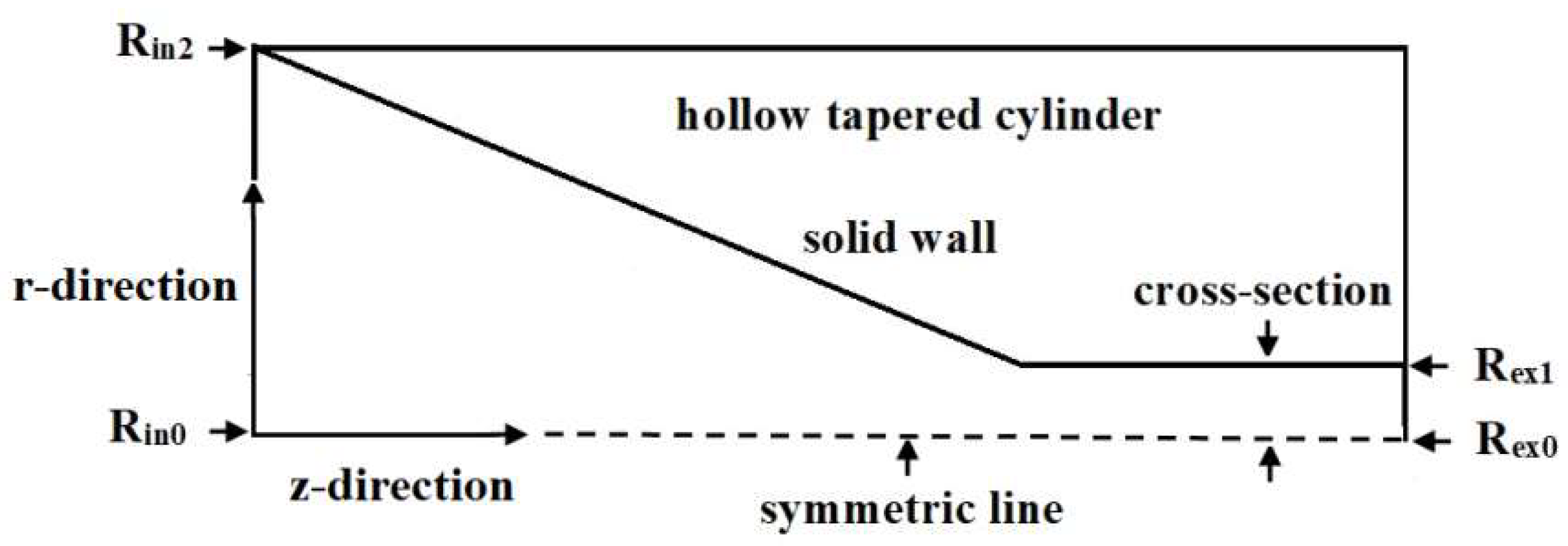

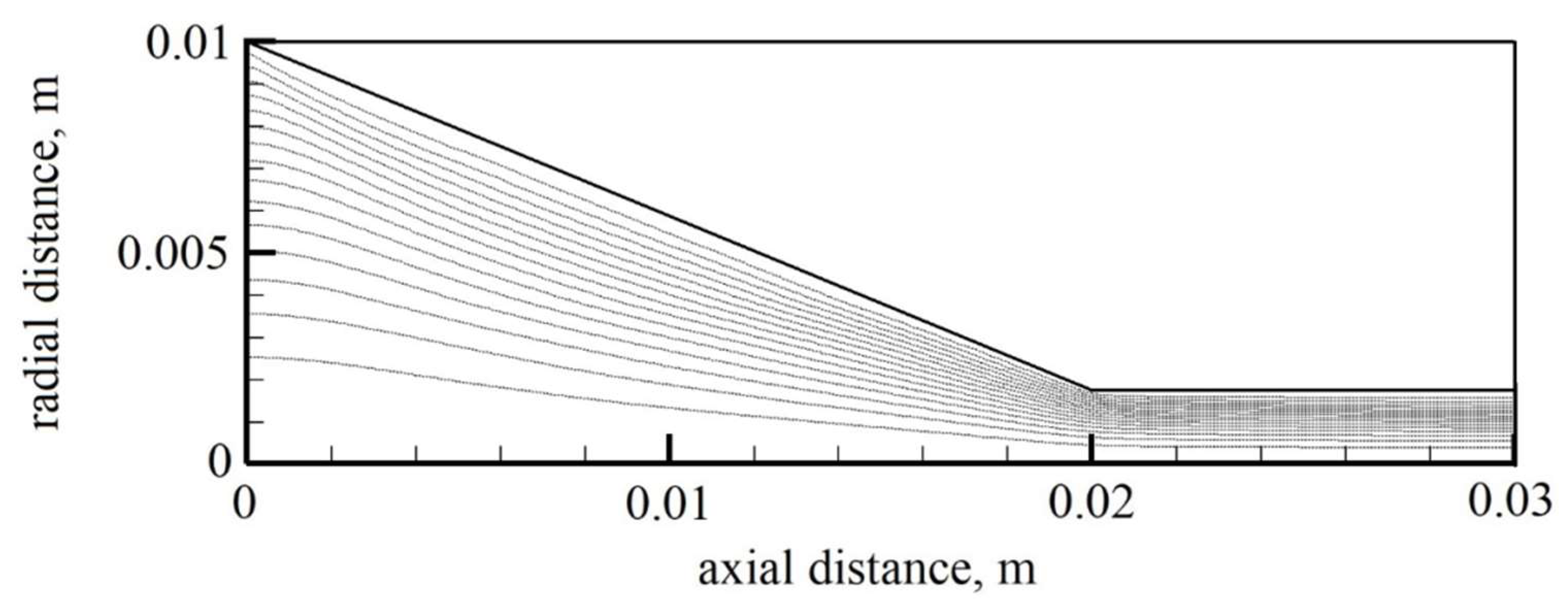
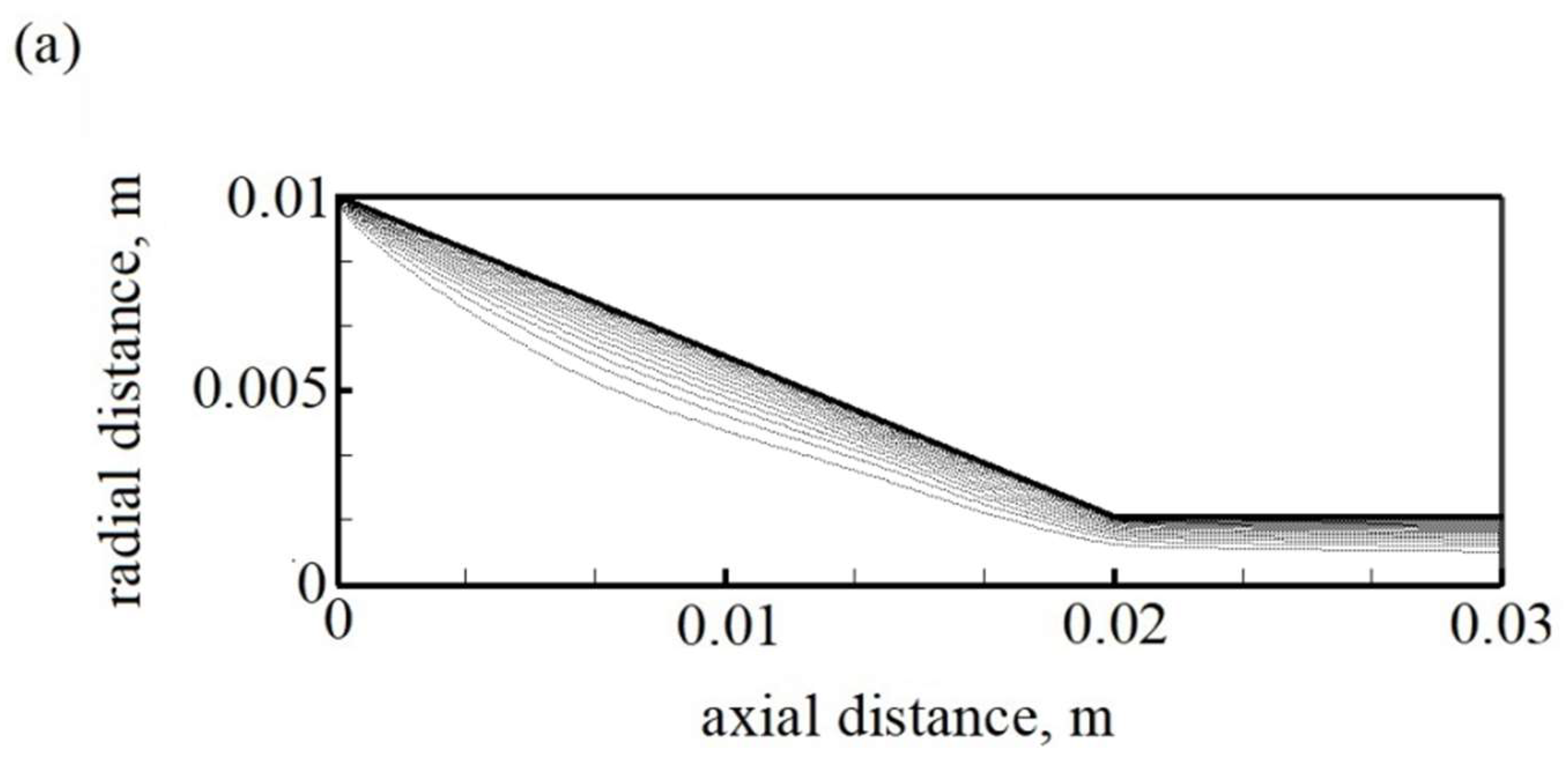
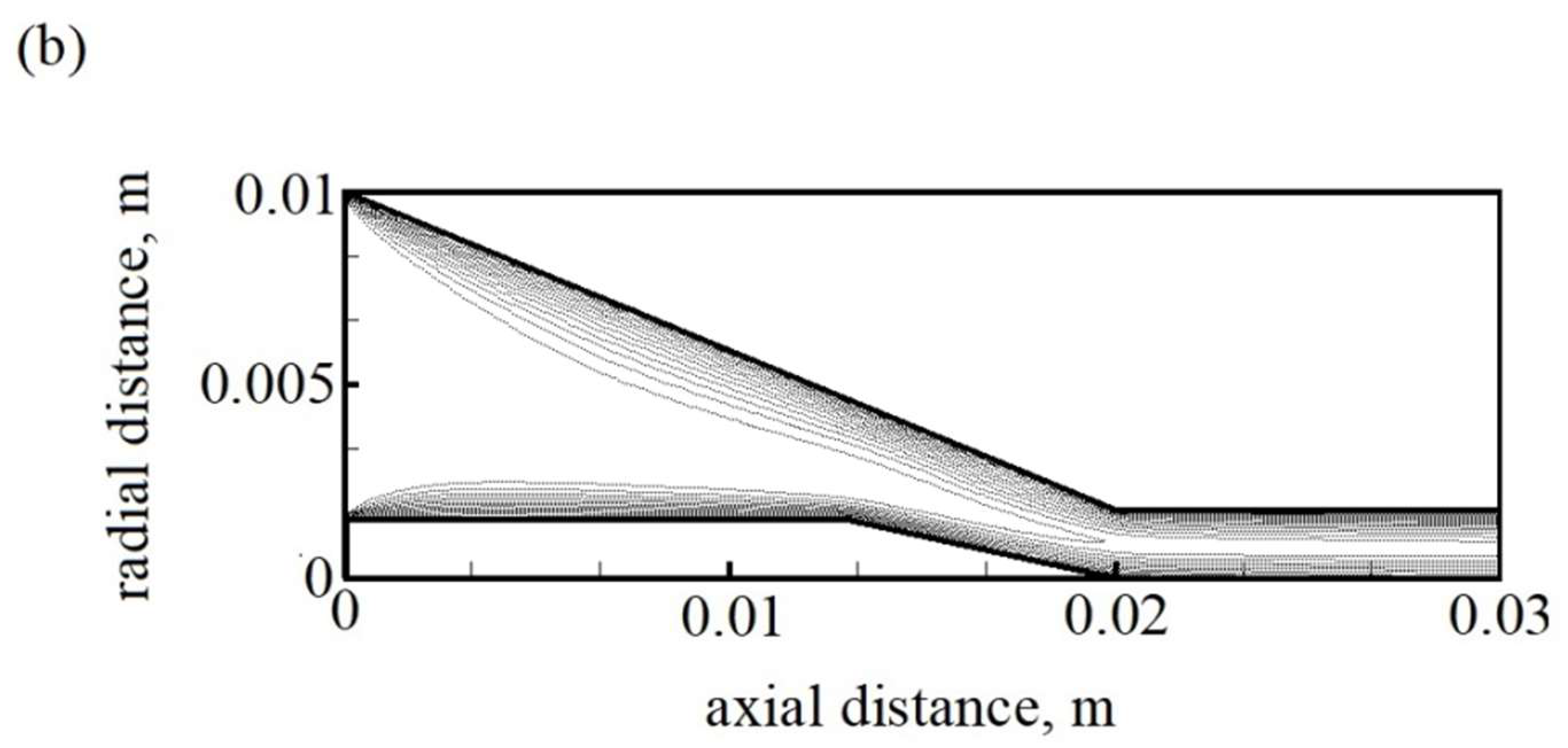
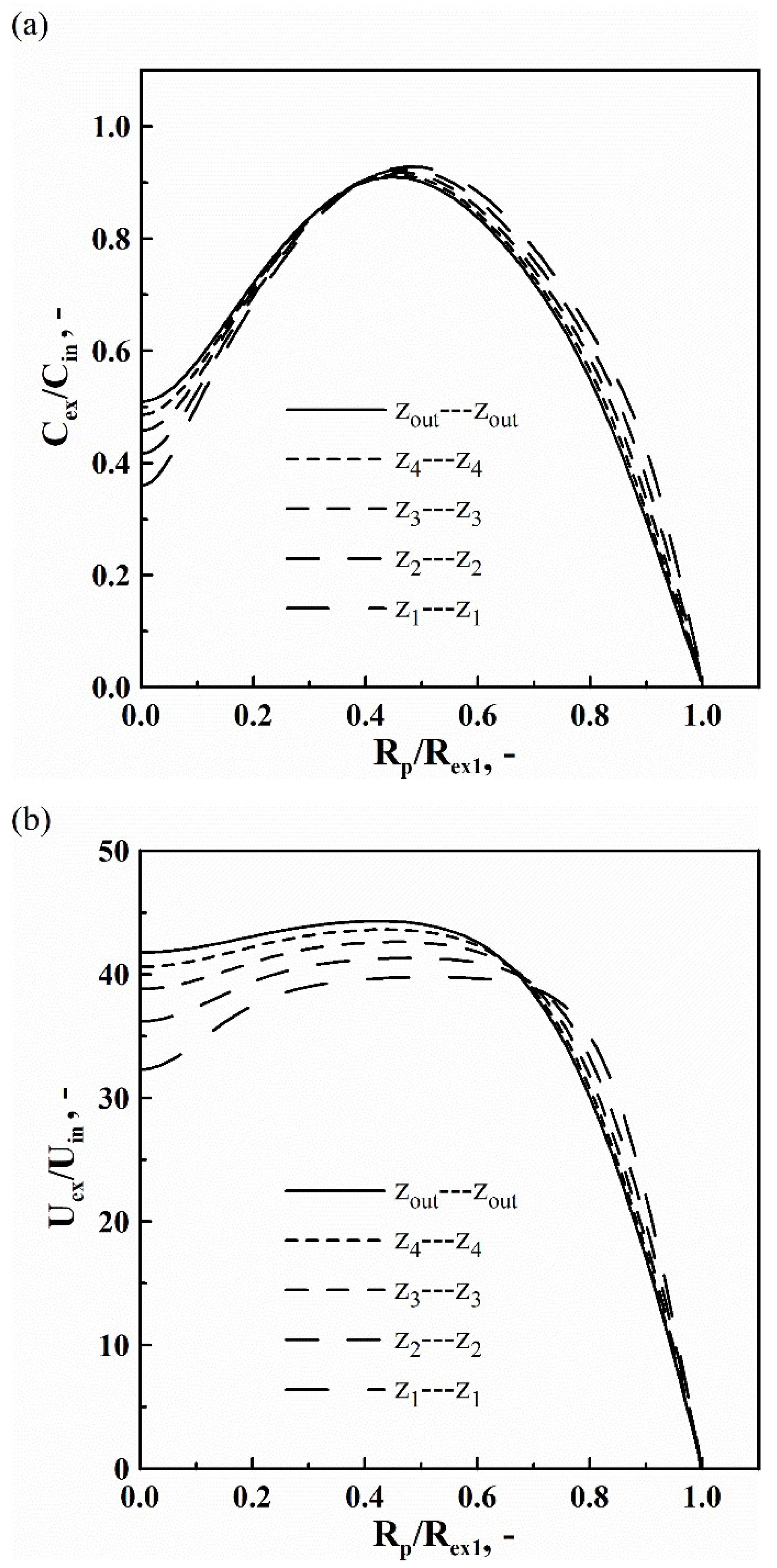

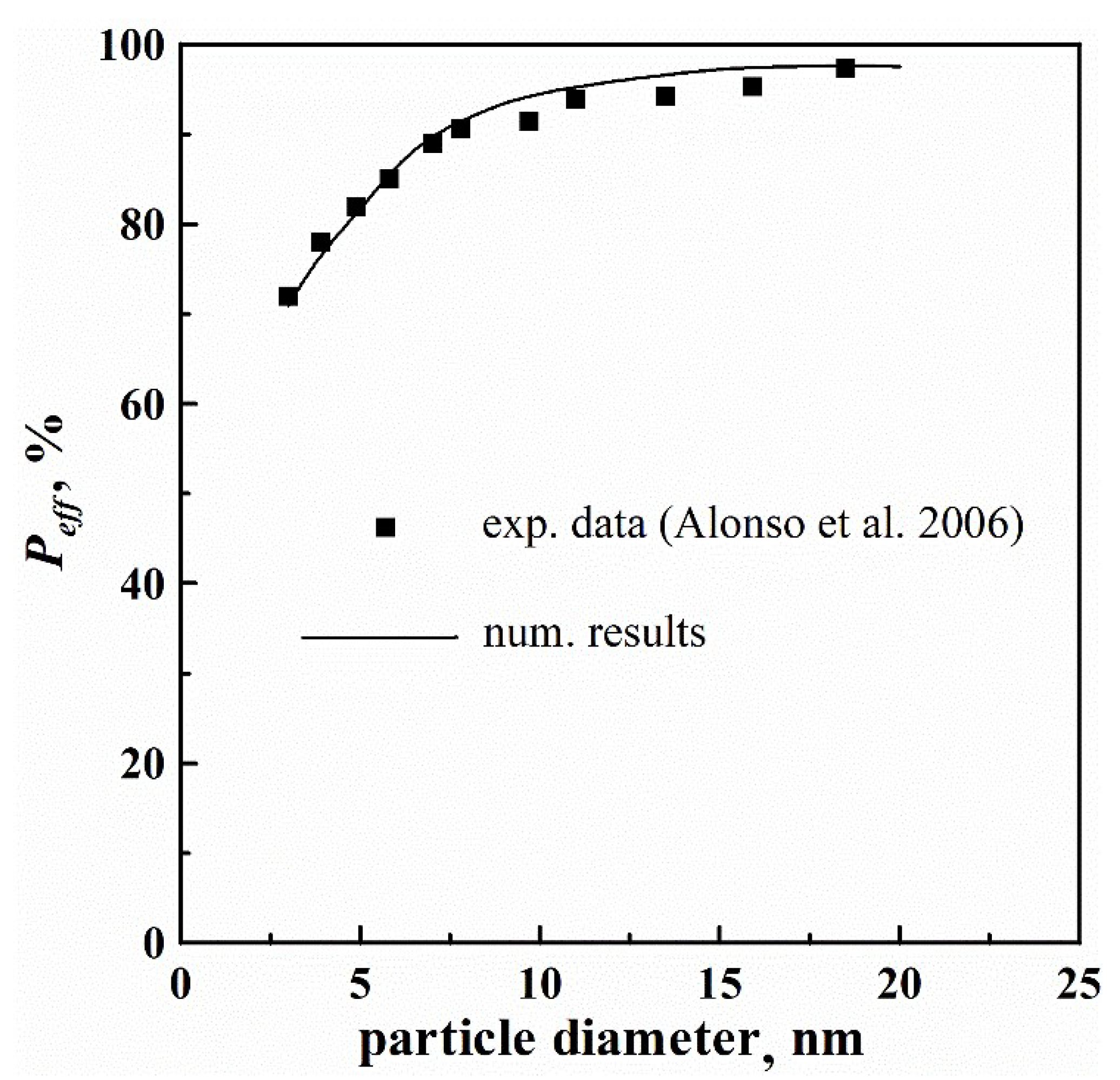


Publisher’s Note: MDPI stays neutral with regard to jurisdictional claims in published maps and institutional affiliations. |
© 2022 by the authors. Licensee MDPI, Basel, Switzerland. This article is an open access article distributed under the terms and conditions of the Creative Commons Attribution (CC BY) license (https://creativecommons.org/licenses/by/4.0/).
Share and Cite
Huang, C.-H.; Lin, Y.-C.; Chang, C.-L. Penetration Efficiency and Concentration Distribution of Nanoparticles in a Hollow Tapered Cylinder. Appl. Sci. 2022, 12, 8025. https://doi.org/10.3390/app12168025
Huang C-H, Lin Y-C, Chang C-L. Penetration Efficiency and Concentration Distribution of Nanoparticles in a Hollow Tapered Cylinder. Applied Sciences. 2022; 12(16):8025. https://doi.org/10.3390/app12168025
Chicago/Turabian StyleHuang, Cheng-Hsiung, Yu-Chih Lin, and Chung-Liang Chang. 2022. "Penetration Efficiency and Concentration Distribution of Nanoparticles in a Hollow Tapered Cylinder" Applied Sciences 12, no. 16: 8025. https://doi.org/10.3390/app12168025





